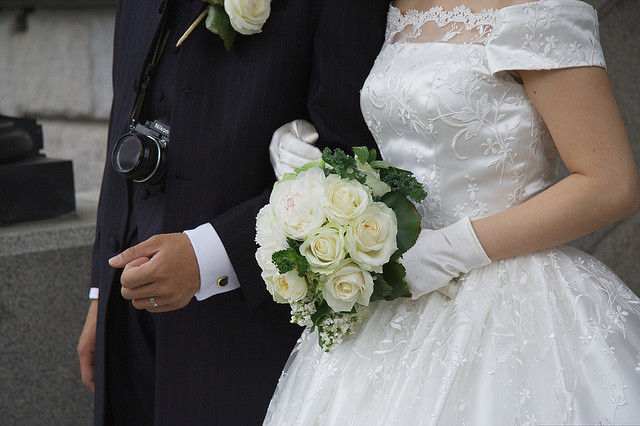
photo by cohue
Even some Japanese people don’t know proper wedding etiquette. This time, so that you won’t panic at the sight of a sudden invitation to a wedding, we will be sharing some must-know proper wedding etiquette.
If you receive an invitation
Usually, an invitation to a wedding is sent as a self-addressed postcard.
How to respond when you will be in attendance
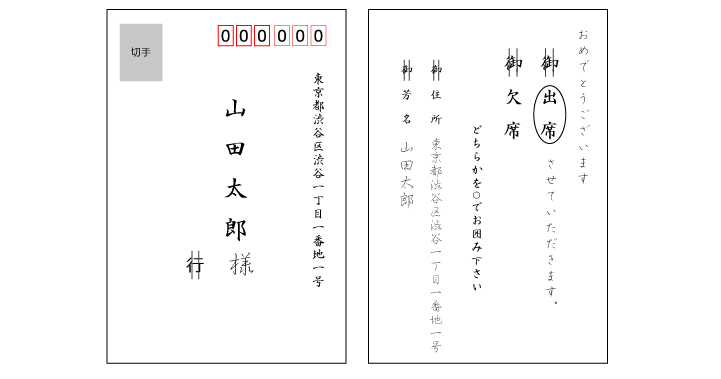
On the front side (the side with the stamp), put two lines through the ‘行 (to)’, or ‘宛 (for)’ under the name and add on ‘様 (honorific suffix)’. Circle ‘will attend’ and put a double line through ‘御 (honoric suffix)’ before 御出席 (will attend)、御欠席 (will not attend)、御住所 (address)、御芳名 (name). The bride and groom will surely be delighted if you add on a cheerful message such as ‘Congratulations’ ‘I surely will attend’ ‘Looking forward to your wedding’. Don’t forget to add on your address and name as well. If you will be attending and send this postcard back, a formal invitation will be sent to you at a later date. Details having to do with the day of, such as the location and time will be written on the formal invitation.
How to respond when you will not be in attendance
When you receive the invitation and you can not attend, it is considered proper etiquette to respond immediately, by telephone or email. The front side is the filled out in the same way as when you will be in attendance. Put two lines through the honorific suffix on the front side, put a circle around ‘will not attend’ and be sure to write in the reason for not attending, along with a congratulatory message and send it off.
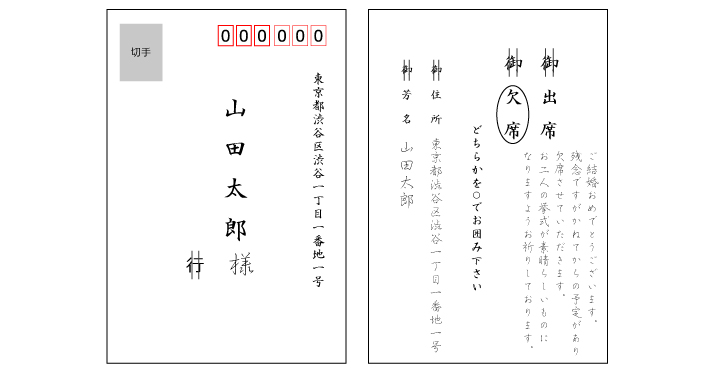
The RSVP date will usually be written, but because they have wedding preparations, be sure to respond as soon as you can. Regardless of whether you decided to attend or not, mail the invitation back. Be careful since it is considered impolite to respond by just telephone or email. Keep in mind you should always use a black pen when filling in the information.
What kind of attire is appropriate?
For men
It is not acceptable for both men and women to wear clothing that is flashier than the bride and groom. For men, a chic ‘black’ ‘gray’ or ‘navy’ suit is typical. Try and choose a ‘white’ shirt. The color of the tie, as long as it is not black, doesn’t matter (A black tie is worn at a funeral so it is considered bad luck).
For women
Women have to keep in mind the color of the dress they’re going to wear. A white dress is the bride’s exclusive right, so avoid wearing a white dress. Also, it is not appropriate to wear all black since it reminds us of Buddhist memorial services. Typical is a formal one-piece dress. It is also proper etiquette to wear shoes that cover the toes in formal occasions.
What is a ‘goshugi (gift money)’?
Goshugi is gift money that is given when you are invited to a wedding. Overseas, it may be customary to gift new household appliances, but in Japan it is customary to gift money.
About how much?
If the bride or groom is a friend, 20,000 – 30,000 yen and if the bride or groom is a superior or a boss at work, it is customary to give more than 30,000 yen. It is best to avoid ’4′ and ’9′ when thinking about how much to give. In Japan, ‘4 – shi (death)’ and ‘9 – ku (suffering)’ are bad luck numbers so it is best to avoid them.
Be sure to put it in a congratulatory envelope
It is not acceptable to give the money unadorned or in a brown envelope. Convenience stores and 100 yen stores sell congratulatory envelopes especially for weddings, so be sure to buy one ahead of time. Since the envelope, color of the mizuhiki (beautifully tied cord) or the way it is tied have specific meanings, you have to be careful; it might be best to just ask the store person ‘which one is for weddings?’
Proper congratulatory envelope etiquette
There is etiquette concerning the congratulatory envelope so be careful. When you buy one, there is an extravagant outer envelope, an inner envelope for the money, and a strip of fancy paper included.
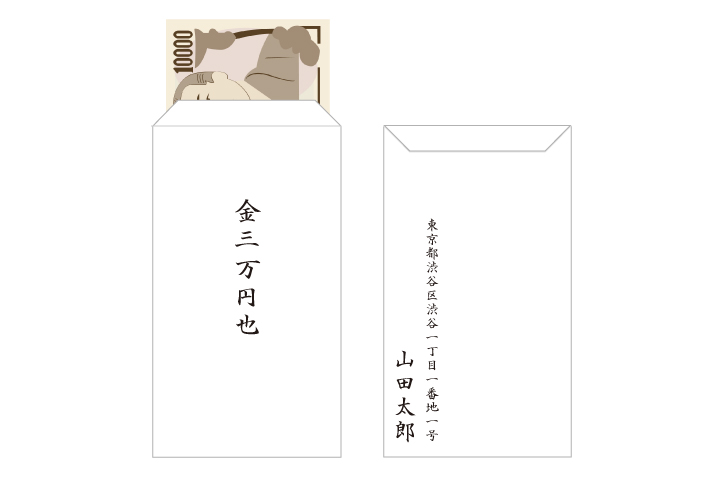
Write the amount enclosed on the front side of the inner envelope and your name and address on the back side. Keep in mind that the bills you enclose should be new. Place the bills inside so that the person on the bill faces the front and is towards the top. And, be sure the bills don’t have any folds and are crisp new ones.
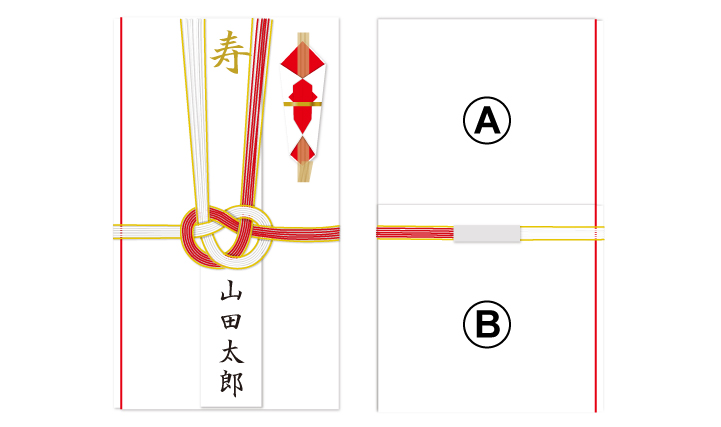
For weddings, pick the fancy strip of paper that has ‘御祝 (Congratulations)’ ‘寿 (Best wishes)’ or ‘御結婚御祝 (Congratulations on your wedding)’ written on it, and write your own name on the lower half. Wrap the inner envelope that you prepared earlier with the outer envelope. Keep in mind that the backside of the outer envelope should be so that B is on top of A. If this is done backwards, it has a meaning of a Buddhist memorial service, being very rude, so be careful. For weddings B is always on top.
Proper wedding day etiquette
Depart early the day of
It is not acceptable to be late to weddings. Be sure to give yourself plenty of time when heading to the venue. If for whatever reason you think you will late, be sure to call the venue. Do not contact the bride or groom.
Leave excess belongings with the cloak.
Leave your coat and larger sized belongings with the cloak.
Greetings at the reception
Be sure to first say ‘Congratulations’ when you’re standing at the reception. Give the prepared congratulatory envelope to the receptionist. Wrap it with a special silk wrapping cloth called a fukusa until you hand it over and when handing it over, turn the envelope around so that the receptionist can read the information easily, and be sure to use both hands to hand it over.
Proper wedding ceremony etiquette
Be careful not to step in the center aisle when entering a church wedding. Guests enter through the aisles on both sides. In both Christian types and Shinzenshiki, the wedding is considered a sacred event so talking during the wedding is not allowed. The venue staff will inform you about photography before the wedding ceremony starts, so be sure to listen and follow instructions.
Proper reception etiquette
For the toast, choose a drink from the menu. If you choose something off the menu, it will surely delay the procession of the reception. If it is western cuisine, you are sure to be at a loss with all the forks and knives in front of you, but start using the utensils on both the right and left, outside in. The reception usually lasts about 2 hours. Try to go to the restroom or smoke when the bride and groom are sitting or are chatting. Try not to stand up or eat, in the middle of speeches, entertainment, or presentations. Outside the venue, the bride and groom, their parents and the matchmaker will be waiting to see you off. Offer compliments such as ‘What a beautiful reception’ or congratulatory words and thanks to the bride and groom.
Summary
You might be at a loss at your first wedding, but it will be fine if you keep the basics in mind. Be sure to have the time of your life since you were so graciously invited. You can decide whether to take part in the afterparty. You have congratulated them sufficiently at the wedding so it will not be considered impolite if you choose not to take part. What is important are the congratulatory feelings you offer the bride and groom. Enjoy the wedding with a feeling of commendation.
Related Article:
Painful if you don’t know!? First-timer etiquette guide to Funerals
